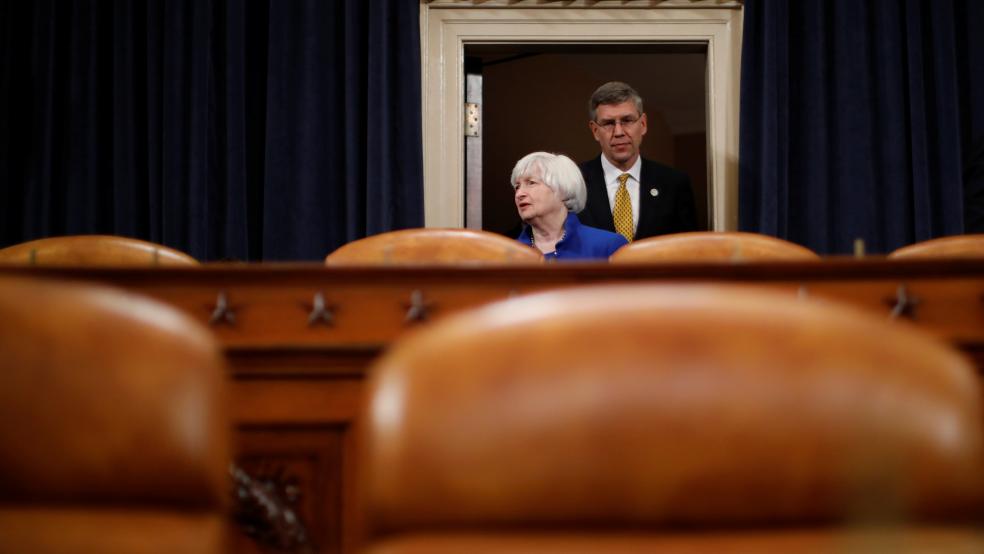The market has spent seven years tethered to the Federal Reserve's every utterance, but now it appears ready to move on.
This may well have been the moment everyone on Wall Street has been waiting for.
Related: Putting Wall Street First: GOP Attacks Plan to Help Millions Save for Retirement
Instead of recoiling in terror at the thought that the Fed not only is ready to hike interest rates but also is prepared to do so on a regular basis, the market essentially has shrugged. No wailing, no gnashing of teeth, just a general recognition that higher rates are in the future and that doesn't spell looming catastrophe.
Indeed, the notable part of the reaction was that there was so little reaction, even though the unmistakable momentum for a rate hike seemed to come out of nowhere.
"A March rate hike ... would mark the first time in years that the Fed raised rates when it did not obviously have to do so, in the sense that it was under no pressure either from markets or from its own prior signals to push ahead with an increase," strategists at Evercore ISI said in a note to clients. "This is interesting and in our view has informational content."
The move to hike in March is significant in large part because it indicates the Fed is on a more aggressive trajectory than the market originally thought. Amid the current economic and political climate — not to mention a national debt quickly approaching $20 trillion — a tighter Fed has many implications.
However, Evercore believes the hike should be interpreted not as hawkish, or signaling a more aggressive path to higher rates, but rather as a bullish indicator of confidence in the economy.
A hike out of nowhere
After years of waffling over economic progress and devising reason after reason not to hike, central bank officials from Chair Janet Yellen on down are finally ready to pull the trigger.
"This can be — evidently is — a bullish (risk-on) hike," Evercore added. "Market participants know that the Yellen Fed is super-careful and would not move ahead on hiking earlier than was evidently required unless it was very confident in the outlook — this endorsement can boost confidence and coordinate expectations to a stronger world."
How it all came to be, though, is pretty striking.
Just two weeks ago, the market was putting a less than 1-in-4 chance of a hike. By the time last week had ended and senior Fed officials, including Yellen, had made public speeches, the tide had turned completely.
Related: Wall Street steady after Yellen signals rate hike this month
Traders, according to the CME's tracking tool, now assign an 86 percent chance of an increase at the March 14-15 Federal Open Market Committee meeting — a virtual lock when considering Fed history.
"There's not really that much logic to what the Fed is doing in the sense that they should have been doing this a long time ago," said Joseph LaVorgna, chief U.S. economist for Deutsche Bank who in the past has said the Fed should have been raising sooner.
LaVorgna feared the Fed would wait too long and be pushed into hiking more aggressively once the economy and inflation picked up.
He has cited "significant improvement in soft data," such as business, consumer and investment surveys indicating that confidence is building.
"If you add all those things, it certainly makes sense for the Fed to hike sooner," LaVorgna said. "I'm surprised they got the courage after coming up with every excuse in the past not to move."
Strength around the world
Much attention has been paid to the U.S. presidential election and the emergence of Donald Trump's pro-growth agenda of lower taxes and new government spending. Stocks rallied while keeping government bond yields in check, and financial conditions have loosened.
Related: Wall Street slips on Trump turbulence, North Korea action
The closely watched Citigroup Economic Surprise index, which measures data compared to expectations, is around its highest level in three years, as the most of the data continue to come in relatively strong.
However, the Fed has been basing policy not only on how the U.S. recovery is coming along, but also on how things are shaping up globally. Indications that Europe isn't about to collapse beneath its sovereign debt load and that Chinahas a firmer grasp on its slowing growth have helped contribute to a growing sense of confidence on a global level.
"It's a broad-based flood of better economic momentum evidence," said Jim Paulsen, chief investment strategist at Wells Capital Management. "It's also not just real growth, it's nominal — reinflation showing up in a lot of places around the globe."
Paulsen points to several other indicators, particularly gains in median income, that the Fed should use as green lights for more rate hikes.
"I think it's more than a March rate hike. They're putting themselves on a schedule for three to four rate hikes a year," he said.
For now, Fed officials continue to indicate there will be three hikes this year and probably three more in 2018. However, there's already growing speculation that the FOMC moves in March, June and September then enacts a de facto hike in December by announcing that it will begin rolling off some the $4.5 trillion in fixed income assets on its balance sheet.
The committee at its upcoming meeting also will release its summary of economic projections that could provide more clues about the expected growth path ahead, and the corresponding expectations for interest rates.
This article originally appeared on CNBC. Read more from CNBC:
BofA Merrill Lynch just raised its target for the S&P 500 — but not for a good reason
4 ways McDonald's is about to change
Market likes ‘teleprompter Trump’ way more than ‘Twitter Trump,’ analyst says




